What I see, and hear, is noise in the quiet bits - using Audacity, can amplify both 16 and 24 bit files to the point where it's easily audible in say, a laptop - different qualities to the noise, but still noise, or hiss - a slight noise by the drummer is a touch more clear and recognisable in the 24b through the noise, but there's not much in it.Try this:
https://www.dropbox.com/s/fzptrndp7avwya5/16b_24b.zip?dl=0
16 bits x 24bits, same recording (a friend of mine, enthusiast). Take a very good audio equipment, no notebooks, no smartphones. Warning, initial part has very low volume, followed with high volume kicks. In the first half, you may hear quantization noise from 16b file, with good headphones and good headphone amplifier.
Interestingly, the track has been spliced at about the 30 sec mark, from 2 takes possibly, with a large slab of digital "silence" inserted. Here the difference in quantisation noise is very marked, but everywhere else the noise level in the record chain dominates.
What I see, and hear, is noise in the quiet bits - using Audacity, can amplify both 16 and 24 bit files to the point where it's easily audible in say, a laptop .
Duh, not the point. Set the volume so the drum is comfortable and then go back to the beginning WITHOUT turning up the volume. What is it people don't get about actual listening context?
Actually I had a sociopathic roommate 40 yr ago that used to play my LP's and constantly adjust the volume to keep it at 11. He also used to boil frankfurters and spaghetti in a pot and eat the mess with his hand and call it dinner.
Last edited:
Yes, I would have thought that was obvious ...Duh, not the point. Set the volume so the drum is comfortable and then go back to the beginning WITHOUT turning up the volume. What is it people don't get about actual listening context?
But ... now I know why you have a thing about higher sound levels
No. I have recordings to confirm. Never seen any real work of yours, over years here, but plain arguing and disputing.
Recordings to confirm that it's audible? When? When you're only playing digital silence, the volume is turned all the way up and you have a lot of excess gain?
se
Whatever, I don't hear a thing.
Not even when you're peeking?
se
Duh, not the point. Set the volume so the drum is comfortable and then go back to the beginning WITHOUT turning up the volume. What is it people don't get about actual listening context?
It's incredible, isn't it?
I guess these people never really listen to music, just the noises their systems can make.
It's like the person complaining that they have some hum coming from their speakers, but can only hear it when nothing is playing and they walk over and put their ear right next to the speaker.
se
Last edited:
Did he pee in the kitchen sink too?
No but he slept on a mattress clothes and all with no sheets for months, MIT hates to admit that they let in a few of the fringe characters.
I tried again ASUS Xonar U5, Sennheiser 650's, and foobar still nothing.
Last edited:
Scott
Just out of curiosity when was the last time you had a hearing test?
ES
I'll gladly repeat the test with a measurement mic and record the SPL, just no turning it up till you can see it. As you might have noticed the dither article I posted a while back noted 40db of gain was needed to hear anything.
Last edited:
Please keep in mind many of my systems do run at 102-105db.
I do get my hearing tested every few years. The standard tests really don't go very high in frequency but they do show threshold levels quite well.
BTY I don't think you need to call yourself a fringe character.
I do get my hearing tested every few years. The standard tests really don't go very high in frequency but they do show threshold levels quite well.
BTY I don't think you need to call yourself a fringe character.
Last edited:
Please keep in mind many of my systems do run at 102-105db.
I do get my hearing tested every few years. The standard tests really don't go very high in frequency but they do show threshold levels quite well.
BTY I don't think you need to call yourself a fringe character.

BTW did you listen to PMA's files without turning up the volume?
Last edited:
If people want to see what the fuss is about, here's Pavel's 16 bit file, then a copy amplified by 30dB - note the normally audible signals now ferociously clipping, then another copy amplified 60dB. In the latter you can see the steps of quantisation noise, along with clipping galore,  ; note at the 30-36 sec interval the noise has dropped a bit - this is digital silence inserted.
; note at the 30-36 sec interval the noise has dropped a bit - this is digital silence inserted.
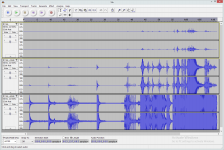

Downside I find satellite radio unlistenable.
Which of course has nothing to do with this.
then another copy amplified 60dB.
View attachment 483141
In this case what's the point?
Many people use headphones again, today. And, noise and artifacts need to be really, really low as your ear is right up against the speaker while it produces music.
Too bad Waley doesnt live next door to me... what he could do with all these racks and shelves full of test equipment. Every few years I do a purge to make room for the next batch of instruments. I'm in that purge process now:
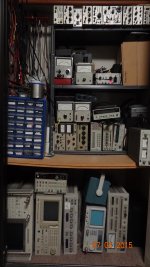
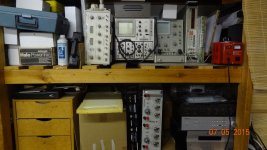
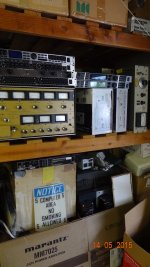
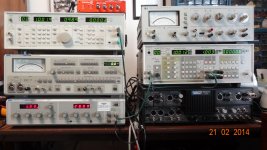
Making room for jitter testing and some other new items.
THx-RNMarsh
Too bad Waley doesnt live next door to me... what he could do with all these racks and shelves full of test equipment. Every few years I do a purge to make room for the next batch of instruments. I'm in that purge process now:




Making room for jitter testing and some other new items.
THx-RNMarsh
Last edited:
- Status
- Not open for further replies.
- Home
- Member Areas
- The Lounge
- John Curl's Blowtorch preamplifier part II